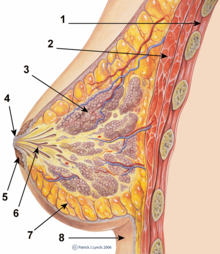teat
In the higher mammals, a teat is the raised mouth of a mammary gland complex . The breast teats of primates, including humans , are called nipples because of their position and formation .
construction

A teat is usually cylindrical and elongated. It consists of a cavity ( cistern ) into which the outlet ducts of several mammary glands open together and a teat duct, which forms the common outlet of the mammary glands from the cistern. The teat is encased by skin tissue that forms both the cistern and the teat passage as a duplicate.
The nipples of the primates do not represent real teats. In their case, the ducts lead directly to an elevation of the skin, which is known as the "nipple".
Schematic representation of the human milk ridges loco typico
Location and number
The teats of mammals are laid out in pairs and can differ greatly in terms of their location in the different animal groups.
As a rule, they lie in pairs along a belly-sided, paired milk bar that extends from the chest to the groin region . This form of localization is known as thoraco-inguinal and is present in, for example, most mammals such as rodents , insectivores , most predators, and some ungulates such as pigs . In some groups of mammals such as primates , bears or elephants , the teats are limited to the thorax ( mammary glands ); this is referred to as a thoracic localization. In ruminants and horses in particular , the teats concentrate on the groin area (inguinal localization) and form an udder here .
The number of teats in mammals is adapted to the average litter size . As a rough rule of thumb , the number of teats should be twice the average number of young animals.
Sandy mammary glands of a woolly pig
Teat formula
The number of teats and the distribution of the teats between pectoral and inguinal teat pairs can be described by the so-called teat formula. In addition to the notation listed below, 2-2 = 8 or 2 + 2 = 8 is also used in the literature.
- Examples:
- 0/2 = 4 - there are no pectoral and two inguinal pairs of teats, i.e. 4 teats.
- 1/1 = 4 - there is a pectoral and an inguinal pair of teats, i.e. 4 teats.
- 2/0 = 4 - there are two pectoral and no inguinal pairs of teats, i.e. 4 teats.
- 3/2 = 10 - there are three pectoral and two inguinal pairs of teats, i.e. 10 teats.
function
In all mammals, the teats serve to efficiently supply the offspring with food. In contrast to monotones , where the milk escapes through a milk field in the fur and the young animals have to lick up the milk that escapes, the teats offer the young animals a direct sucking point that they can put in their mouths and from which they suck milk if necessary can.
Web links
supporting documents
- ↑ a b Gerhard Storch: Mammalia, mammals. In: W. Westheide, R. Rieger: Special Zoology. Part 2. Vertebrate or skull animals. Spektrum Akademischer Verlag, Munich 2004; Pp. 446-447, ISBN 3-8274-0307-3 .
- ↑ Jochen Niethammer: The number of Mammae in Pitymys and in the Microtinen. In: Bonn zoological Bulletin (BzB) Volume 23, March 1972. P. 51 ( Online ; PDF; 3.8 MB).
- ^ Fritz Dieterlen: On the knowledge of Delanymys brooksi Hayman 1962 (Petromyscinae; Cricetidae; Rodentia). In: Bonn zoological Bulletin (BzB) Heft 4, 20/1969, p. 389. ( Online ; PDF; 3.8 MB).




